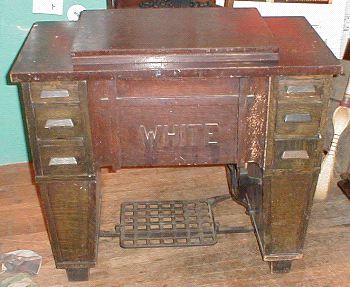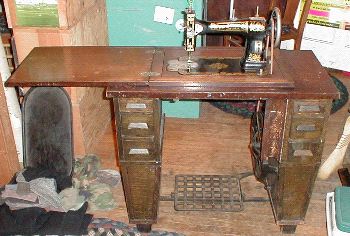

okay. so after a long round of hijinks, i finally have a white family rotary in the mission cabinet up and working!
well call it frankenmission.
see, first there was this idea - i really wanted a white in this cabinet, but figured id never find one. then, i bought an old beat up minnesota model c, because it was cheap, and i really wanted a treadle sewing machine. of course, this was immediately followed by a mission white popping up on ebay, and i nabbed it for around $100, but then had to figure out how to get the blasted thing from rural pennsylvania (where the seller, who wouldnt ship, was from) to san francisco. this resulted in frantic scrambing, because i hadnt actually expected to win the auction, so i called freight companies like mad, trying to come up with a plan, and finally ended up realizing that that was just too expensive - so i turned to friends. ah, friends, theyll always come through. my friend judith from nyc pulled through like a champ - took greyhound to philly, rented a car, drove to scranton, picked up the cabinet, drove back to philly, packed it all up, and hopped greyhoud back to nyc, and stored it all in her house. for several months. brought the head out in jan 2004, and then shipped the rest in mar 2004. judith, you RULE. but there was now a problem... all the small parts that i needed to put the whole thing back together were now missing, lost somewhere in the disassembly! argh! so now, having sold the minnesota, i was stuck without a working sewing machine until i jury-rigged this one back together, or foudn the spare parts. of course, right about this time, another mission white came up on ebay, located ever so conveniently in southern california... murphys law, hard at work! so i spent the next few months trying to figure a way out of the quandry, until jul 2004, when another mission white popped up on craigslist, in napa. it was missing some bits, but i knew it had enough to be able to cobble together one nicely working cabinet/machine, and have leftovers to jury-rig a 2nd at some later date. so i bought the other mission white for $50, and merged the two.
behold, frankenmission!
the drawers/legs and the machine head are from #1, and the top, front drop panel, treadle and flywheel are all from #2. you can see the difference in finish here, but in the standard light of my room you cant really notice the difference, and in the end, i dont really care all that much - the bottom line is, the blasted thing works!
before (left) and after cleaning pics of the machine head
left side view - showing the bobbin case/shuttle, presser foot, and needle bar
i called white (1 800 446 2333) to get a date based on the serial number (FR 424831) - they said 1911! based on some listings id seen elsewhere, i was guessing mid-20s, so this was neat to find out. the head is in pretty good shape, really - it just needed cleaning. it seems there might be a slight bend in the driveshaft out near the handwheel, but after cleaning and oiling it doesnt affect the easy motion of the wheel at all, so im not too worried about it. all the transfers are in great shape, and the metal bits, while not gleaming, are all clean and free of rust. i could go through the whole thing and make it shine, but simply clean and well-lubed is good enough for me. now that its all cleaned up, it runs really smooth and quiet - much moreso than my minnesota did - and sews a really nice, even, straight stitch. now im just waiting on a few bits that didnt get shipped with the cabinet, and i can put the whole thing together!
it was interesting to note the differences between the 2 cabinets - #1 i think is an earlier version - the drawers dont have individual locks like #2 does - they latch via a spring-loaded mechanism that somehow ties in to the head being raised (i am still missing parts, so i have not yet figured out exactly how this was supposed to work). also, the head platform is hinged in back to fold out of the way of the flywheel when being lowered, while #2 has a solid head platform with a little spring-loaded door in the right rear to clear the flywheel. theres also some minor differences in the castings for the treadle and the flywheel guard.
regardless, its a great machine, really smooth and quiet, and sews nice as can be!
attachments typically (or not so typically) found with/for White FRs:
Here's some attachments that came with my machine, and some others that I have acquired later on. If I've got any id'ed wrong, or if you can identify anything unknown, please let me know!
narrow hemmer and 3/16", 1/4", 3/8", 5/8" and 7/8" wide hemmers
binder, edge stitcher, foot gatherer and quilter foot
tucker and ruffler
quilter guide, shirring plate, underbraider plate?, scissors gauge and screwdriver
unknown braider foot, and unknown bit
anyone with any info relating to the above pics, please email me! thanks!
the main thing to remember is that the white is a rotary shuttle machine, rather than a vibrating shuttle, and the shuttle and threading arrangements are completely different than on singers or other standard sewing machines - slightly more complex, but not that bad. the other thing you have to remember is that the drive turns the opposite direction as compared to most other machines - the handwheel spins away from you its top, rather than towards, which requires a different treadling motion when starting up.
threading instructions, from the white family rotary manual
(letters correspond to those on the above photo, which is linked to a bigger version)
place the spool on spool pin, take the thread in your left hand holding it taut with the right during the whole threading operation. pass thread from spool over check spring K at top of face and down under point L.
now pull thread upward until it passes through the eye of spring N and into notch O, then into end of take-up P then down through slot R in end of needle bar and through eye of needle from left to right, allowing about 3 inches of thread when take-up is at its highest point.
to draw up the lower thread, raise the presser-foot, take hold of end of upper thread and turn the hand wheel once round, (moving upper side of wheel from you), which will draw the lower thread up through needle hole.
pass the ends of both threads under the presser-foot and you will be ready to sew.
you will note that slot R at the end of the needle bar is not illustrated, but its pretty obvious if youve got a machine in front of you... its the little loop just above where the needle fixes into the needle bar.
the white definitely has a better range of stitches than my minnesota did - the latter only had 7, 10, 14 and 24 stitches/inch, while the white can do (by my rough measurements) 5.75, 6, 7, 8.5, 11, 15, 22 and 46(!) - corresponding to settings 7 down through 1 on its stitch length regulator.